Some History
Mexico pre-Conquest - in a nutshell
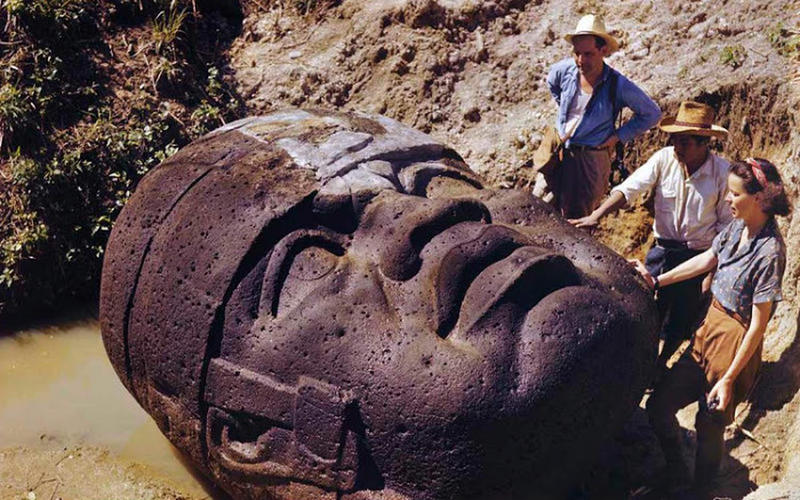 Olmec, Maya, Teotihuan, Toltec and Aztec: Prior to the Spanish conquest, Mexico had been home to civilizations for literally thousands of years. Most of these reached beyond Mexico to include Central America in general. The earliest we know of, the Olmec, was in existence certainly no later than 2,000 BC. The last was the Aztec, conquered by the Spaniard Hernán Cortéz and allied armies in 1521.
Olmec, Maya, Teotihuan, Toltec and Aztec: Prior to the Spanish conquest, Mexico had been home to civilizations for literally thousands of years. Most of these reached beyond Mexico to include Central America in general. The earliest we know of, the Olmec, was in existence certainly no later than 2,000 BC. The last was the Aztec, conquered by the Spaniard Hernán Cortéz and allied armies in 1521.
Olmec: The height of the Olmec civilization is often dated as stretching from roughly 1500-300 BC. They are especially famous for the huge, stone heads they sculpted. Since we have not discovered any writing associated with the Olmec, we don't know if the heads represented deities, rulers, or what. In addition to the huge heads, the Olmec also produced other fine sculpture and erected pyramids. Their pyramids were made of packed earth and have been reduced to mounds of clay, but their stone art has survived in remarkably good condition. The center of the civilization was on the Pacific coast in what is today southern Mexico, but it is clear that it stretched well beyond the center, from central Mexico to Costa Rica and probably beyond.
>Maya: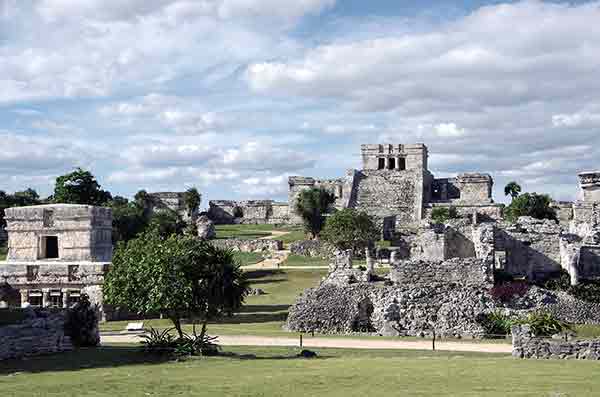 Next in line, chronologically speaking, we have the Maya. This civilization stretched from roughly 300BC-900AD, although it was in decline after 300-400AD. Geographically speaking, it stretched from the Atlantic to the Pacific, and flourished especially in the Yucatán peninsula of Mexico through Guatemala. It does not seem to have been a unified kingdom but rather a bunch of city-states, kind of like in the Greek civilization.
Next in line, chronologically speaking, we have the Maya. This civilization stretched from roughly 300BC-900AD, although it was in decline after 300-400AD. Geographically speaking, it stretched from the Atlantic to the Pacific, and flourished especially in the Yucatán peninsula of Mexico through Guatemala. It does not seem to have been a unified kingdom but rather a bunch of city-states, kind of like in the Greek civilization.
The Maya had stone pyramids, and a writing system, the general outlines of which have been deciphered. They were primarily farmers, and apparently developed an agricultural system that permitted them to comfortably feed their large population (some 100,000 people in some cities) through practices that did not require large amounts of water, important in the semi-arid regions in which some of their cities were located. As a child, I visited one of the sites of Mayan ruins (Uxmal) and climbed its pyramid. That, in some respects, inspired my life-long interest in other cultures. My mother, who visited many more Mayan sites, used to tell me that you could hardly walk through the jungles of Guatemala without stumbling upon a Mayan ruin!
Teotihuacan: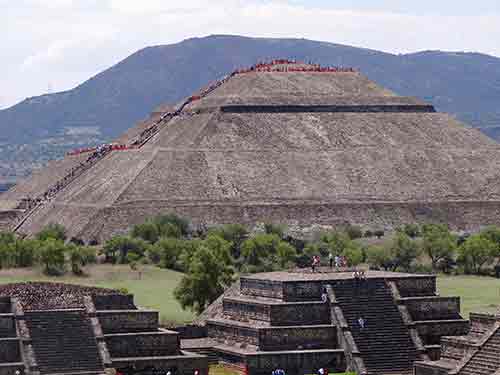 Towards the end of the Mayan civilization, there is some indication that the Maya were in contact with the Teotihucanos - although whether this was through trade or conquest is unclear. In addition, at some point during the decline of the Maya, representations of what is probably Quetzalcóatl began to appear. (Quetzacoatl then continued on as an important deity through all the subsequent civilizations of Mexico and Central America.)
Towards the end of the Mayan civilization, there is some indication that the Maya were in contact with the Teotihucanos - although whether this was through trade or conquest is unclear. In addition, at some point during the decline of the Maya, representations of what is probably Quetzalcóatl began to appear. (Quetzacoatl then continued on as an important deity through all the subsequent civilizations of Mexico and Central America.)
The origins and history of the Teotihuacanos are extremely murky. Evidently, they flourished before the Maya civilization ended and continued on after that. They also constructed the huge, impressive buildings (including the famous pyramid and Temple of the Sun) located close to Mexico City, which suggests that central Mexico was most important to them.
Toltec: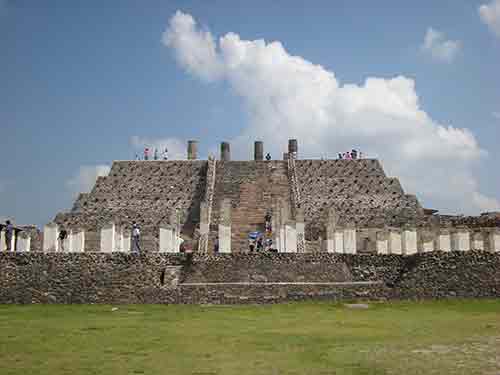 The Teotihucanos disappeared as mysteriously as they appeared. The civilization was followed, or accompanied, by the Toltecs whose civilization dates from approximately 800-1000AD. Their "home territory" was also in central Mexico, and they are generally said to be the the precursors of the Aztecs.
The Teotihucanos disappeared as mysteriously as they appeared. The civilization was followed, or accompanied, by the Toltecs whose civilization dates from approximately 800-1000AD. Their "home territory" was also in central Mexico, and they are generally said to be the the precursors of the Aztecs.
The four objects on top of the Toltec pyramid to the left, which appear to be pillars, are in fact carved, stone statues of people/deities that are about two times taller than a normal human being. The Toltecs also carved many representations of Quetzacoatl.
Aztecs: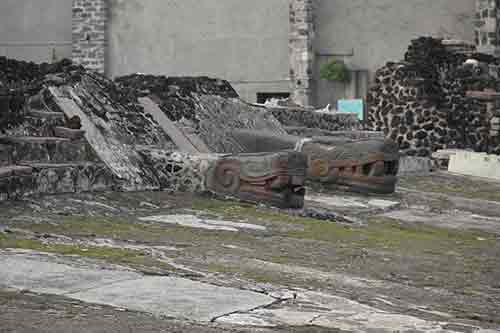 And finally, we get to the Aztecs. This was a unified civilization under the rule of a king or emperor. With a capital in central Mexico - where today's Mexico City is located - the Aztec rule began in 1325. It ended in 1521 with the Spanish conquest. The Aztecs, like the civilizations before them, build pyramids to bring them closer to the gods, and constructed great cities with public buildings of stone, decorated by intricate bas-reliefs. In addition to having a complex writing system, they were also particularly good astronomers, and their empire reached from the Atlantic to the Pacific, due in large part to almost continuous conquest. (The conquest helped destory them because when the Spaniards arrived, conquered peoples were happy to ally themselves with these Europeans to bring down the Aztec rule.)
And finally, we get to the Aztecs. This was a unified civilization under the rule of a king or emperor. With a capital in central Mexico - where today's Mexico City is located - the Aztec rule began in 1325. It ended in 1521 with the Spanish conquest. The Aztecs, like the civilizations before them, build pyramids to bring them closer to the gods, and constructed great cities with public buildings of stone, decorated by intricate bas-reliefs. In addition to having a complex writing system, they were also particularly good astronomers, and their empire reached from the Atlantic to the Pacific, due in large part to almost continuous conquest. (The conquest helped destory them because when the Spaniards arrived, conquered peoples were happy to ally themselves with these Europeans to bring down the Aztec rule.)
Aztec rule was, however, paricularly bloody. I am talking here not so much about warfare as about the ritual human sacrifice perpetrated by the rulers and their priests in the name of religion. Ironically, the numbers of people killed through these practices is probably much less than the thousands executed in Spain, in the name of religion, during the first 60 years of the Inquisition (which began in 1478). The human sacrifices of the Aztecs were closely tied to the rulers rather than the general population, so that when the rule had been destroyed, other aspects of the culture took over.
The Aztecs worshipped many deities. One of the most important was Quetzacoatl, the "feathered serpent" who we first saw with the Maya, and who both of our artists celebrate. While much of the Aztecs' capital city has been lost - first due to the Spanish conquest and more recently, due to the modern city being built on top of it - archaeological work is uncovering some of the great buildings. The photograph above on the left shows a pair of Quetzacoatl upholding the base of the pyramid that used to rise above it.
